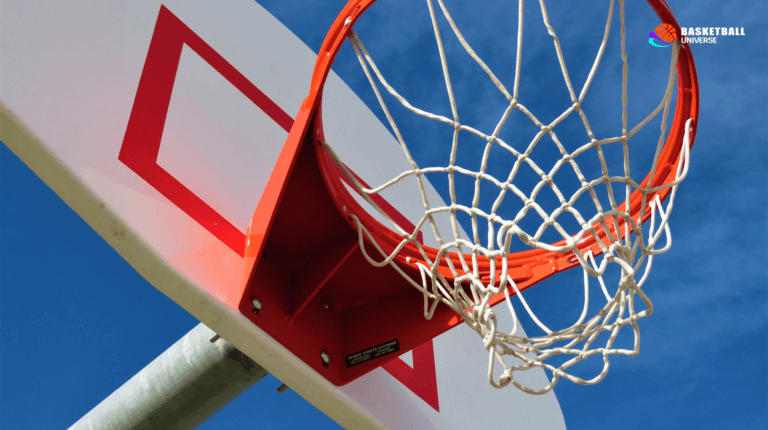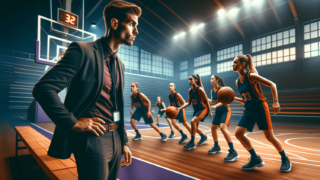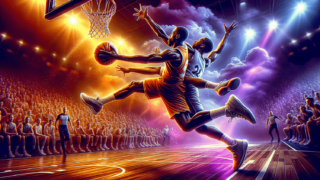
What Is a Brick in Basketball?
Written by: Basketball Universe
Last updated:

Welcome to the world of basketball terminology, where we explore the ins and outs of one of the most exciting sports on the planet! In today’s post, we’re going to delve into the meaning behind the term ‘brick’ and why it holds particular significance on the court. If you’ve ever been curious about what exactly a brick is and why it’s used to define certain shots in basketball, then you’ve come to the right place. So, lace up your sneakers, grab your favorite basketball, and get ready to unravel the mystery behind this fascinating term!
What Is a Brick in Basketball?
A brick in basketball refers to a poorly executed shot that has little to no chance of going through the hoop, typically resulting in a hard rebound off the backboard or rim. The term is derived from the idea that a brick is heavy and difficult to handle, much like the way an unsuccessful shot feels in the context of the game. Players often use this term to describe shots that are not only off-target, but also lack the necessary touch and finesse required for a successful attempt.
Understanding the Origins of the Term ‘Brick’
The origins of the term “brick” in basketball are not entirely clear, but one popular theory traces the term back to street basketball games, where players would use bricks to make the backboard or rim. This would often result in a very hard and unforgiving bounce when the ball contacted the backboard or rim. This similarity led to the adoption of the term ‘brick’ to describe shots that miss their mark and have a hard bounce, similar to the sensation of a ball hitting a brick backboard.
Identifying a Brick Shot
A brick can occur due to multiple factors, making it essential for players and enthusiasts to understand the various components of a poorly executed shot. The ability to recognize and analyze each aspect may help players improve their shooting technique and reduce the frequency of bricks.
Improper Shooting Form
A primary cause of brick shots is improper shooting form. When a player does not have a consistent shooting technique in place, they are more likely to shoot bricks. Proper shooting form involves holding the ball with a relaxed grip, extending the shooting arm and following through with a fluid motion, and maintaining a straight body alignment from head to toe. By understanding and practicing these elements, players can reduce the chances of shooting bricks.
Insufficient Arc and Trajectory
The arc and trajectory of a shot play a critical role in determining whether it will result in a swish or turn into a brick. An ideal arc allows the ball to enter the basket at a desirable angle, increasing the chances of scoring. A shot with too low of an arc is more likely to generate a brick, as the ball is more likely to hit the rim or backboard at an unfavorable angle, causing an abrupt rebound.
Lack of Spin or English
Applying adequate spin, or English, to the basketball can greatly impact its trajectory and accuracy. A properly spun basketball will have enough rotation to stabilize its flight path and increase its chances of scoring. A shot with little to no spin often results in a brick, as it is more difficult to control and accurately shoot.
Failure to Account for Game Parameters
In-game situations may also contribute to brick shots. Factors such as defensive pressure, player fatigue, and court condition have the potential to influence a player’s shooting accuracy. Understanding these variables and accounting for them can help players adapt their shooting techniques to avoid bricks during gameplay.
Minimizing Bricks: Tips for Improved Shooting Technique
To elevate their shooting prowess and effectively minimize bricks, basketball players can put several actionable tips and techniques to the test. Mastering the following fundamentals may bolster shooting accuracy and keep brick shots at bay.
Refine Your Shooting Form
Develop and maintain a consistent shooting form. A consistent and accurate shot begins with a proper form, which includes a balanced stance, a strong base, and a smooth follow-through. Work on these aspects of your shooting form and practice them regularly to see improvements in your shot accuracy.
Master the BEEF Technique
B.E.E.F., which stands for Balance, Eyes, Elbow, and Follow-through, is a popular acronym that helps players remember the key components of a successful shot. Use this framework as a basis for practicing and improving your basketball shooting skills to reduce the likelihood of bricks.
- Balance: Maintain a stable base throughout the entire shooting motion, keeping your feet shoulder-width apart and your knees slightly bent.
- Eyes: Focus your eyes on the target (the rim or a specific spot on the backboard) throughout the entire shot.
- Elbow: Position your elbow in proper alignment, keeping it under the ball and directly above the bend in your shooting knee.
- Follow-through: Extend your shooting arm and release the ball with a smooth, fluid motion. Your shooting hand should resemble a “gooseneck” at the end of the follow-through.
Utilize a Shooting Arc
Optimize the trajectory of your shot by focusing on shooting with a higher arc. This can be achieved by releasing the ball with more lift and following through fully. By concentrating on this aspect of your shot, you can work towards minimizing the harsh rebounds often associated with brick shots.
Practice with Purpose
Instead of simply aiming to make as many shots as possible during practice, focus on deliberate and purposeful actions to improve your shooting technique. Work on specific fundamentals, like hand placement and footwork, in addition to game-like scenarios, like shooting under pressure and from various spots on the court.
Analyze Your Shots and Make Corrections
Pay attention to the outcome of each shot and make adjustments as necessary. If you notice a pattern of bricks, identify the cause and work to correct it through practice and repetition. Regularly analyzing your shots and making the appropriate corrections will help refine your shooting ability, reducing the chances of shooting bricks.
Beyond the Bounce: The Psychological Impact of Bricks in Basketball
While bricks have a tangible effect on scoring and gameplay, their ramifications extend beyond the bounce of the basketball. A player’s mental state can be influenced by their shooting performance, either motivating future successes or contributing to continued struggles.
The Effect of Bricks on Confidence
Constantly shooting bricks can have a negative impact on a player’s confidence. They may falter in high-pressure situations or opt not to attempt a shot at all, potentially hindering their overall performance on the court. Developing mental fortitude and focusing on incremental improvements can help attenuate these concerns and foster a positive, confident mindset.
Constructive Feedback and Positive Reinforcement
To combat the psychological toll that bricks may inflict, players, coaches, and teammates should emphasize constructive feedback and highlight successes. Offering specific and targeted advice on how to improve technique or recognizing exceptional plays in-game can work to counterbalance the negative associations tied to brick shots. Ultimately, a supportive and reinforcing environment fosters growth and success on the basketball court.
Embracing the Learning Curve
It’s crucial to remember that brick shots are an inevitable part of the learning process. As players develop and refine their skills, progress is often accompanied by setbacks and struggles. By acknowledging the inherent nature of bricks within the game, players can view these problematic shots as an opportunity to learn, adapt, and enhance their skills on the court.
With a comprehensive understanding of bricks in basketball, both in terms of their technical origins and impact on gameplay and psychology, players are better poised to address and improve upon this all-too-common occurrence. With targeted practice, keen observation, and a growth-oriented mindset, minimizing brick shots and cementing success on the court is well within reach.
Incorporating Drills to Overcome Bricks
Integrating specific shooting drills into practice sessions can play a pivotal role in elevating a player’s shooting skillset and minimizing the frequency of brick shots. These drills typically focus on honing a player’s technique, strengthening their mental resolve, and enhancing their ability to perform under pressure.
Form Shooting Drill
This fundamental shooting drill emphasizes establishing and maintaining proper shooting form. Players begin by shooting close to the basket and gradually move further away, all the while concentrating on maintaining good form. By continuously practicing this drill, players can strengthen their muscle memory, resulting in improved shot accuracy and a reduced likelihood of bricks.
Pressure Shooting Drill
This drill simulates the pressure and intensity of shooting in a game situation. Players must shoot a predetermined number of free throws or shots from certain spots on the court, often with a specific success rate or time limit. This drill is designed to help build players’ confidence in high-pressure situations and enhance their ability to consistently execute successful shots, thereby minimizing the occurrence of bricks.
Beat the Pro Drill
This competitive shooting drill places a player in a one-on-one contest against an imaginary “pro” player. With each shot attempt, the real player and the imaginary pro receive points based on made or missed shots. For example, the player might receive 2 points for a made shot, while the imaginary pro would get 1 point for each miss. The objective is to reach a predetermined point total before the imaginary pro does. Not only does this drill help players work on their shot accuracy, but the competitive component also helps build mental resilience and motivation.
Notable NBA Players and Their Approach to Shooting Bricks
Even the best basketball players occasionally experience brick shots. Indeed, the manner in which renowned NBA players respond to and handle brick shots can serve as a valuable lesson for aspiring athletes.
Michael Jordan’s Unwavering Confidence
Widely regarded as one of the greatest basketball players of all time, Michael Jordan was well-known for his prowess on the court, including his clutch shooting ability. However, he also experienced his share of brick shots. Jordan’s sheer confidence in his ability and refusal to shy away from attempting crucial shots, despite previous bricks, propelled him to numerous successes and highlighted the value of maintaining a positive and unwavering mindset.
Steph Curry’s Proactive Practice
Stephen Curry, currently considered one of the best shooters in NBA history, is a prime example of how consistent practice can lead to an exceptional shooting touch that reduces brick shots. By honing his craft through countless hours of drills, Curry developed a keen understanding of his shooting form and mechanics, which allowed him to adapt and troubleshoot during games to maintain peak performance.
LeBron James’ Evolution as a Shooter
LeBron James, known for his all-around talent, has shown continued growth throughout his career in terms of shooting accuracy. Early in his career, James faced occasional criticism for brick shots or a perceived reluctance to take clutch shots. However, by focusing on improving his shooting through practice and experience, James has steadily evolved and minimized brick shots in high-pressure situations, demonstrating the importance of embracing a growth mindset.
Ultimately, analyzing how elite basketball players perceive and respond to their brick shots can offer invaluable lessons to aspiring athletes. By adopting the tenets of confidence, proactive practice, and a growth-focused attitude, players can better equip themselves to minimize brick shots and excel on the court.
Frequently Asked Questions
We’ve compiled a list of frequently asked questions regarding brick shots in basketball to help readers further their understanding of this particular aspect of the game. Dive into these common queries to deepen your comprehension of bricks and how they affect performance on the court.
1. Why is it called a brick in basketball?
A brick in basketball refers to a missed shot that rebounds forcefully off the backboard or rim, similar to the sensation of a ball striking a hard, unforgiving object like a brick. The term likely originated from street basketball games, where backboards and rims were often made of bricks or had bricks incorporated into their construction.
2. Can good shooters still shoot bricks?
Yes, even good shooters can occasionally shoot bricks. Brick shots can occur due to various factors, such as defensive pressure, player fatigue, or a momentary lapse in shooting form. Great shooters often work to minimize bricks through rigorous practice, maintaining confidence, and honing their mental fortitude during gameplay.
3. How does poor shooting form contribute to brick shots?
Poor shooting form can generate inconsistent shots that miss their mark, resulting in brick shots. Players with improper shooting form may struggle to control the ball’s trajectory, manage their body alignment, or maintain necessary touch and finesse when attempting shots.
4. What does the acronym BEEF stand for in basketball shooting?
B.E.E.F. stands for Balance, Eyes, Elbow, and Follow-through. It serves as an easy-to-remember framework for the key components of a successful shot, helping players improve their shooting form and technique to reduce the chances of shooting bricks.
5. What is a good shooting arc in basketball?
A good shooting arc is one that allows the ball to enter the basket at an optimal angle, increasing the likelihood of scoring. Generally, a higher arc is more favorable, as it provides a greater margin for error while ensuring the ball approaches the basket at a desirable angle. This can help reduce the incidence of brick shots, which often have lower arcs and less favorable trajectories.
6. How can players counteract the psychological impact of bricks?
To counteract the psychological impact of bricks, players can focus on building mental fortitude, maintaining confidence, and seeking constructive feedback. Additionally, recognizing that bricks are a natural part of the game can help alleviate some of the pressure associated with missed shots, allowing players to adapt and learn from their mistakes.
7. How do NBA players deal with brick shots?
NBA players deal with brick shots by maintaining confidence in their abilities, engaging in consistent practice, and adopting a growth mindset to continually improve their shooting technique. They also develop mental resilience to better cope with high-pressure situations and the inevitable occurrence of missed shots during games.
8. What are some effective shooting drills to minimize bricks?
Effective shooting drills to minimize bricks include the Form Shooting Drill, Pressure Shooting Drill, and Beat the Pro Drill. These drills focus on developing proper shooting form, improving accuracy under pressure, and fostering competitive motivation, all of which contribute to a player’s overall shooting performance.
9. Can fatigue contribute to bricks?
Yes, fatigue can contribute to bricks, as a tired player may struggle to maintain proper shooting form or make necessary adjustments to their shot during gameplay. Incorporating conditioning drills and practicing shooting while fatigued can help players develop the stamina and strength needed to perform consistently throughout a game.
10. How does defensive pressure affect shooting accuracy?
Defensive pressure can impact shooting accuracy by forcing players to rush their shot or adjust their shooting form due to the presence of a defender. To mitigate the effects of defensive pressure, players can practice shooting under simulated pressure and work on decision-making skills during gameplay to choose the most effective shot opportunities.
11. How can players adjust their shooting form based on in-game parameters?
During gameplay, players can make adjustments to their shooting form by recognizing and adapting to situational factors, such as defensive pressure, varied court conditions, or their current fatigue levels. This may involve adjusting their shooting speed, technique, or decision-making process based on the in-game context.
12. How does the trajectory of a shot affect the occurrence of bricks?
The trajectory of a shot greatly impacts its chances of success, with a low or flat arc often resulting in brick shots due to unfavorable angles when contacting the rim or backboard. By developing a higher and more consistent shot arc, players can reduce the likelihood of bricks and improve their overall shooting accuracy.
13. Can adjusting hand placement on the ball help minimize brick shots?
Yes, adjusting hand placement on the ball can greatly affect shooting accuracy and help minimize brick shots. Utilizing a relaxed grip, spreading the fingers for optimal stability and control, and positioning the shooting hand’s fingertips on the seams of the basketball can all contribute to a more accurate and consistent shot.
Featured Posts
- No pillar pages found.




